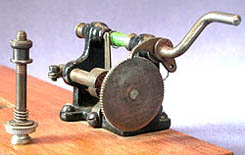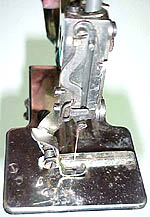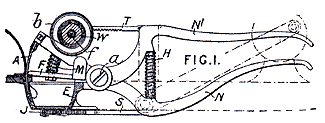


|
Sewing
shears.
On October 5th 1858 Joseph E. Hendrick patented his revolutionary sewing machine "shears" in the USA. The basic concept of the machine is best explained using Hendrick's own words: "The nature of my invention consists in the application of sewing mechanism to a device similar to shears, whereby the opening and shutting of the shears performs the functions of sewing. Thereby a very simple, portable, cheap, and efficient machine is constructed, that can be used in the hand in a manner similar to shears, and applied to the work instead of the work being applied to it; or the said shears may be screwed to the table or other convenient place or support and the cloth presented to the 'sewing-shears'." The simple chain stitch design incorporated a toothed wheel to feed the cloth. The machines were made from brass, this being finished in silver plate. The company of Nettleton & Raymond, Bristol, Connecticut, are attributed as the manufacturers. Production of the machine appears to have been very short-lived. The
basic principle of scissors or shears type was revisited more
than 20 years later. W. F. Thompson's patent
saw the light of day in the UK on 21st October 1884. |
 Original box |
 Independent bobbin winder |
| 1888
saw W. R. Goodbody unveil
a new lockstitch patent
on the "shears" theme. Again of nickel-plated steel construction,
a fully functional four motion underfeed was envisaged this time.
Production machines were stamped on the cloth plate, with a Sept
4th 1888 patent date, also that of the American Hand 1884, plus
a further Nov 10th 1885 patent. The UK 1888 patent is dated May 23rd. |
| Observing
extant examples reveals two quite distinct types. One of these replicates
the patent specification very closely, so we can probably ascribe
this as the first model. The second type underwent considerable changes, i.e. the needlebar head was totally redesigned, and now incorporated a round needlebar instead of the original square section one. A spring loaded rocking action presser foot replaced the more conventional lever lift, and last but not least, the top thread take up system was heavily revised. An original box from this latter type attributes the marketing of this machine to "The Manhattan Machine and Novelty Company" of New York. |
 Modified Goodbody |
| So far we have discussed the well known 19th century production models that today's collectors are familiar with, but it is well worth noting that further early shear types may well have been marketed. |
 Hughes patent |
In 1895 G. Hughes, in communication with H. Strauscheidt, patented a lockstitch shears machine primarily aimed at the leather industry. One not for the squeamish would be an 1897 model designed by A. Sykes. This offering describes a surgical application for a hand held device. GD |
 Sykes patent |
© All content copyright protected.